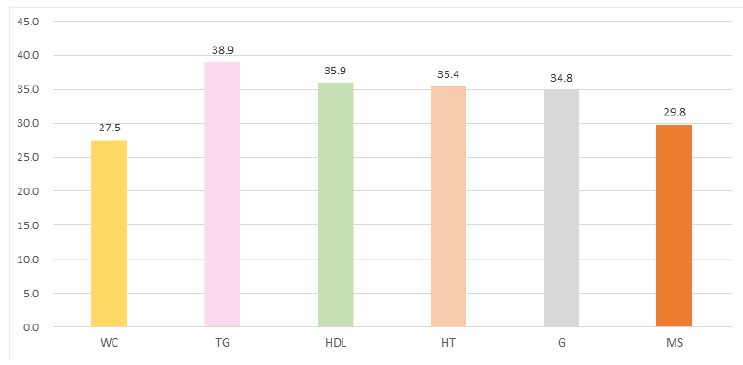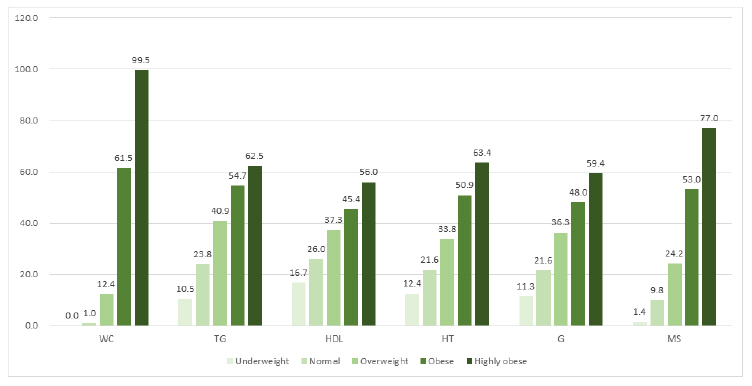Korean J Health Promot.
2020 Dec;20(4):144-150. 10.15384/kjhp.2020.20.4.144.
The Obesity and the Metabolic Syndrome among Korean Adults: Based on National Representative Survey
- Affiliations
-
- 1College of Nursing/Health and Nursing Research Institute, Jeju National University, Jeju, Korea
- KMID: 2509870
- DOI: http://doi.org/10.15384/kjhp.2020.20.4.144
Abstract
- Background
The obesity and metabolic syndrome (MetS) are main health issues worldwide. This study was to investigate the association of obesity and MetS.
Methods
A secondary analysis was conducted using data from Korea National Health and Nutrition Examination Survey for this study. The data from 10,488 Korean adults who were 30-64 years old were utilized and the pooled weights for the stratified complex sampling were implemented in the analysis. The participants were divided into five groups based on body mass index (BMI), and waist circumference, triglyceride, high density lipid, glucose, and blood pressures were used for the MetS.
Results
The prevalence of MetS was 29.8% and it was higher in highly obese adults than people who has normal weights (odds ratio, 36.9; 95% confidence interval, 25.9-52.3) after adjusting age, gender, education, income, job, smoking, high risk drinking, and physical activity. There was gradients for the MetS and the components of MetS according to BMI.
Conclusions
The obesity increased the risk of MetS and its components’ prevalence. The targeted intervention to control weight need to be developed and implemented. Further researches might be also needed to evaluate the effect of the weight loss on the decreased the risk of MetS.
Keyword
Figure
Reference
-
1. Saklayen MG. The global epidemic of the metabolic syndrome. Curr Hypertens Rep. 2018; 20(2):12.
Article2. Nilsson PM, Tuomilehto J, Rydén L. The metabolic syndrome -what is it and how should it be managed? Eur J Prev Cardiol. 2019; 26(2_suppl):33–46.3. Alberti KG, Eckel RH, Grundy SM, Zimmet PZ, Cleeman JI, Donato KA, et al. Harmonizing the metabolic syndrome: a joint interim statement of the International Diabetes Federation Task Force on Epidemiology and Prevention; National Heart, Lung, and Blood Institute; American Heart Association; World Heart Federation; International Atherosclerosis Society; and International Association for the Study of Obesity. Circulation. 2009; 120(16):1640–5.4. World Health Organization (WHO). Obesity and overweight [Internet]. Geneva: WHO; 2020 [cited 2020 Oct 25]. Available from: https://www.who.int/news-room/fact-sheets/detail/obesity-and-overweight.5. Center for Disease Control. Defining adult overweight and obesity. Atlanta: Center for Disease Control; 2020 [cited 2020 Dec 18]. Available from: https://www.cdc.gov/obesity/adult/defining.html.6. Kim MH, Lee SH, Shin KS, Son DY, Kim SH, Joe H, et al. The change of metabolic syndrome prevalence and its risk factors in Korean adults for decade: Korea national health and nutrition examination survey for 2008–2017. Korean J Family Practice. 2020; 10(1):44–52.
Article7. Blanquet M, Legrand A, Pélissier A, Mourgues C. Socio-economics status and metabolic syndrome: a meta-analysis. Diabetes Metab Syndr. 2019; 13(3):1805–12.
Article8. Lemes ÍR, Fernandes RA, Turi-Lynch BC, Codogno JS, de Morais LC, Koyama KAK, et al. Metabolic syndrome, physical activity, and medication-related expenditures: a longitudinal analysis. J Phys Act Health. 2019; 16(10):830–5.
Article9. Hirode G, Wong RJ. Trends in the prevalence of metabolic syndrome in the United States, 2011-2016. JAMA. 2020; 323(24):2526–8.
Article10. Li Y, Zhao L, Yu D, Wang Z, Ding G. Metabolic syndrome prevalence and its risk factors among adults in China: a nationally representative cross-sectional study. PLoS One. 2018; 13(6):e0199293.
Article11. Lee SE, Han K, Kang YM, Kim SO, Cho YK, Ko KS, et al. Trends in the prevalence of metabolic syndrome and its components in South Korea: findings from the Korean national health insurance service database (2009-2013). PLoS One. 2018; 13(3):e0194490.
Article12. Gurka MJ, Filipp SL, DeBoer MD. Geographical variation in the prevalence of obesity, metabolic syndrome, and diabetes among US adults. Nutr Diabetes. 2018; 8(1):14.
Article13. Litwin M, Kułaga Z. Obesity, metabolic syndrome, and primary hypertension. Pediatr Nephrol. 2020; May. 9. [Epub ahead of print].
Article14. Han TS, Lean ME. A clinical perspective of obesity, metabolic syndrome and cardiovascular disease. JRSM Cardiovasc Dis. 2016; 5:2048004016633371.
Article15. Kim J, Lee I, Lim S. Overweight or obesity in children aged 0 to 6 and the risk of adult metabolic syndrome: a systematic review and meta-analysis. J Clin Nurs. 2017; 26(23-24):3869–80.
Article16. Mongraw-Chaffin M, Foster MC, Kalyani RR, Vaidya D, Burke GL, Woodward M, et al. Obesity severity and duration are associated with incident metabolic syndrome: evidence against metabolically healthy obesity from the multi-ethnic study of atherosclerosis. J Clin Endocrinol Metab. 2016; 101(11):4117–24.
Article17. Ministry of Health and Welfare; Korean Center for Disease Control. The guidelines for health questionnaire survey in the Korea National Health Examination and Nutritional Survey: The Seventh (2016-2018). Cheongju: Ministry of Health and Welfare, Korean Center for Disease Control;2016.18. Ministry of Health and Welfare; Korean Center for Disease Control. The users' guide for raw data from Korea National Health and Nutrition Examination Survey: The seventh (2016-2018). Osong: Ministry of Health and Welfare, Korean Center for Disease Control;2020.19. Ministry of Health and Welfare; Korean Center for Disease Control. The guidelines for health examination in the Korea National Health Examination and Nutritional Survey: The seventh (2016-2018). Cheonju: Ministry of Health and Welfare, Korean Center for Disease Control;2017.20. Yoon YS, Oh SW. Optimal waist circumference cutoff values for the diagnosis of abdominal obesity in Korean adults. Endocrinol Metab (Seoul). 2014; 29(4):418–26.
Article21. Lee SB, Kim JH. Comparison of dietary behaviors and blood clinical indices in underweight, normal weight, normal weight obese and obese female college students. Korean J Community Nutr. 2018; 23(5):431–43.
Article22. Gao B, Zhang L, Zhao M; China National Survey of Chronic Kidney Disease Working Group Investigator. Underweight but metabolically abnormal phenotype: metabolic features and its association with cardiovascular disease. Eur J Intern Med. 2016; 29:45–51.
Article23. Park E, Kim J. Gender- and age-specific prevalence of metabolic syndrome among Korean adults: analysis of the fifth Korean national health and nutrition examination survey. J Cardiovasc Nurs. 2015; 30(3):256–66.
- Full Text Links
- Actions
-
Cited
- CITED
-
- Close
- Share
- Similar articles
-
- Journal of Obesity & Metabolic Syndrome: A New International Journal Targeting the Pathophysiology and Treatment of Obesity and Metabolic Syndrome
- Obesity and Metabolic Syndrome among Children and Adolescents in Korea
- Association between Eating Alone and Metabolic Syndrome: A Structural Equation Modeling Approach
- Eating Alone and Metabolic Syndrome: A Population-Based Korean National Health and Nutrition Examination Survey 2017-2019
- Evaluation of Metabolic Syndrome in Patients with Chronic Low Back Pain: Using the Fourth Korea National Health and Nutrition Examination Survey Data



